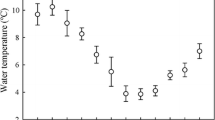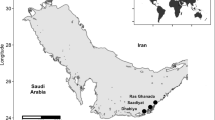Abstract
Geographic variability in the physiological attributes of widely distributed species can be a result of phenotypic plasticity or can reflect evolutionary responses to a particular habitat. In the field, we assessed thermal variability in low and high intertidal pools and the distribution of resident fish species Scartichthys viridis and transitory Girella laevifrons along this vertical intertidal gradient at three localities along the Chilean coast: Antofagasta (the northernmost and warmest habitat), Carrizal Bajo (central coast) and Las Cruces (the southernmost and coldest habitat). In the laboratory, we evaluated the thermal sensitivity of fish captured from each locality. The response to temperature was estimated as the frequency of opercular movements and as thermal selectivity in a gradient; the former being a indirect indicator of energy costs in a particular environment and the latter revealing differential occupation of habitat. Seawater temperature in intertidal pools was greatest at Antofagasta, and within each site was greatest in high intertidal pools. The two intertidal fish species showed opposite patterns of local distribution, with S. viridis primarily inhabiting the lower sectors of the intertidal zone, and G. laevifrons occupying the higher sectors of the intertidal zone. This pattern was consistent for all three localities. Locality was found to be a very important factor determining the frequency of opercular movement and thermal selectivity of both S. viridis and G. laevifrons. Our results suggest that S. viridis and G. laevifrons respond according to: (1) the thermal history of the habitat from which they came, and (2) the immediate physical conditions of their habitat. These results suggest local adaptation rather than plasticity in thermoregulatory and energetic mechanisms.




Similar content being viewed by others
References
Aldana M, Pulgar J, Ogalde, Ojeda FP (2002) Morphometric and parasitological evidence for ontogenetic and geographic dietary shifts in fish. Bull Mar Sci 70:55–74
Angilletta MJ Jr, Niewiarowski PH, Navas CA (2002) The evolution of thermal physiology in ectotherms. J Thermal Biol 27:249–268
Bennett B, Griffiths CL (1984) Factors affecting the distribution, abundance and diversity of rock-pool fishes on the Cape Peninsula, South Africa. S Afr J Zool 19:97
Bennett B, Griffiths CL , Penrith M (1983) The diets of littoral fish from the Cape Peninsula. S Afr Tydskr Dierk 18:343–352
Bennett BA (1987) The rock-pool community of Koppie Allen and assessment of the importance of Cape rock-pools as nurseries for juvenile fish. S Afr J Zool 22:25–32
Bozinovic F, Rosenmann M (1988) Energetics and food requirements of the female snake Phillodryas chamissons during the breeding season. Oecologia 75:282–284
Bozinovic F, Rosenmann M (1989) Maximum metabolic rate of rodents: physiological and ecological consequences on distributional limits. Funct Ecol 3:173–181
Bozinovic F, Rosenmann M, Novoa FF, Medel RG (1995) Mediterranean-type of climatic adaptation in the physiological ecology of rodent species. In: Kalin-Arroyo MT, Zedler PH, Fox MD (eds) Ecology and biogeography of mediterranean ecosystems in Chile, California and Australia). Springer, Berlin Heidelberg New York, pp 347–362
Bridges CR (1993) Ecophysiology of intertidal fish. In: Rankin JC, Jensen FB (eds) Fish ecophysiology. Chapman and Hall, London, pp 375–400
Chown SL, Gaston KL (2000) Areas, cradles and museums: the latitudinal gradient in species richness. Trends Ecol Evol 8:310–315
Collette BB (1986) Resilence of the fish assemblages in New England tidepools. US Fish Bull 84:200–204
Conover DO (1998) Local adaptation in marine fishes: evidence and implications for stock enhancement. Bull Mar Sci 62:477–493
Conover DO, Present TMC (1990) Countergradient variation in growth rate: compensation for length of the growing season among Atlantic silversides from different latitudes. Oecologia 83:316–324
Cossins AR, Bowler K (1987) Temperature biology of animals. Chapman and Hall, New York
Davis BJ (1977) Distribution and temperature adaptation in the teleost fish Genus Gibbonsia. Mar Biol 42:320–345
Davis BJ (2000) Spatial and seasonal patterns of habitat partitioning in a guild of Southern California tidepool fish. Mar Ecol Prog Ser 196:256–268
Gaston KJ, Spicer JL (1998) Do upper thermal tolerances differ in geographically separated populations of the beachflea Orchestia gammarellus (Crustacea: Amphipoda)? J Exp Mar Biol Ecol 229:265–276
Gibson RR (1972) The vertical distribution and feeding relationship of intertidal fish on the Atlantic coast of France. J Anim Ecol 41:189–207
Gibson RN (1982) Recent studies on the biology of intertidal fish. Oceanogr Mar Biol Annu Rev 20:263–414
Gibson RN, Yoshiyama RM (1999) Intertidal fish communities. In: Horn MH, Martin KL, Chotkowski MA (eds) Intertidal Fish. Life in two worlds. Academic Press, San Diego, Calif., pp 95–125
Gosline WA (1965) Vertical distribution of inshore fishes in the upper water layers of the Hawaiians islands. Ecology 46:823–881
Graham JB (1970) Temperature sensivity of two species of intertidal fish. Copeia 1970:49–56
Granterner A, Taborsky M (1998) The metabolic rates associated with resting, and with the performance of agonist, submissive and digging behaviours in the cichlid fish Neolmprolonus pulcher (Pisces: Cichlidae). J Comp Physiol B Biochem Syst Environ Physiol 168:427–433
Grossman GD (1982) Dynamics and organization of a rocky intertidal fish assemblage: the persistence and resilence of taxocene structure. Am Nat 119: 611–637
Grossman GD (1986) Food resource partitioning in a rocky intertidal fish assemblage. J Zool 1:317–335
Hernández CE, Neill PE, Pulgar JM, Ojeda FP, Bozinovic F (2002) Water temperature fluctuations and territoriality in the intertidal zone: two possible explanations for the vertical distribution of body size in Graus nigra (Kyphosidae). J Fish Biol 61:472–488
Horn MH, Gibson RN (1988) Intertidal fish. Sci Am 258:54–60
Horn MH, Martin KL, Chotkowski MA (1999) Intertidal fiskes: life in two worlds. Academic Press, San Diego, Calif.
Huey RB, Bennett AF (1987) Phlyogenetic studies of coadaptation: preferred temperatures versus optimal performance temperatures of lizards. Evolution 41:1098–1115
Lenski RE, Bennett AF (1993) Evolutionary responses of Escherichia coli to thermal stress. Am Nat 142:S47–S64
Lonsdale DJ, Levinton JS (1985) Latitudinal differentiation in copepod growth: an adaptation to temperature. Ecology 66:1397–1407
Metaxas A, Scheibling RE (1993) Community structure and organization of tidepools. Mar Ecol Prog Ser 98:187–198
Morritt D, Ingólfsson A (2000) Upper thermal tolerances of the beach flea Orchestia gammarellus Pallas (Crustacea: Amphipoda: Talitridae) associated with hot springs in Iceland. J Exp Mar Biol Ecol 255:215–227
Moyle PB, Cech JJ (1982) Fish: an introduction to Ichthyology. Prentice Hall, Englewood Cliffs, N.J.
Muñoz AA, Ojeda FP (1997) Feeding guild structure of a rocky intertidal fish assemblage in central Chile. Environ Biol Fish 49:471–479
Muñoz AA, Ojeda FP (1998) Guild structure of carnivorous intertidal fish of the Chilean coast: implications of ontogenetic dietary shifts. Oecologia 114:563–573
Nelson JS (1994) Fish of the world. Wiley, New York
Newell RC (1970) Biology of intertidal animals. Marine Ecological Survey, UK
Norris KS (1963) The functions of temperature in the ecology of the percoid fish Girella nigricans (Aires). Ecol Monogr 33:23–62
Ojeda FP, Labra FA, Muñoz AA (2000) Biogeographic patterns of Chilean littoral fish. Rev Chil Hist Nat 73:625–641
Parsons PA (1993) The importance and consequences of stress in living and fossil populations: from life-history variations to evolutionary change. Am Nat 142:S6–S20
Piersma T, Drent J (2003) Phenotypic flexibility and the evolution of organismal design. Trends Ecol Evol 18:228–233
Prochazka K, Griffiths CL (1992) The intertidal fish fauna of the wet coast of South Africa species, community and biogeographic patterns. S Afr J Zool 27:115–121
Pulgar J, Bozinovic F, Ojeda FP (1999) Behavioral thermoregulation in the intertidal fish Girella laevifrons (Kyphosidae): the effect of starvation. Mar Freshwater Behav Physiol 32:27–38
Ralston SL, Horn MH (1986) High tide movements of the temperate-zone herbivorous fish Cebidichthys violaceus (Girardi) as determined by ultrasonic telemetry. J Exp Mar Biol Ecol 98:35–50
Ricklefs RR (1990) Ecology. Freeman, New York
Rogers SC, Weatherley AH (1993) The use of opercular muscle myograms as an indicator of the metabolic costs of fish activity in rainbow trout, S. gairdneri Richardson, as determined by radiotelemetry. J Fish Biol 23:535–547
Spicer JL, Gaston KG (1999) Physiological diversity and its ecological implications. Blackwell, Oxford
Stearns SC (1982) The evolutionary significance of phenotypic plasticity. Bioscience 7:436–445
Stephen CA, Porter WP (1993) Temperate, activity, and lizard life histories. Am Nat 42:273–293
Stephenson TA, Stephenson A (1972) Life between tidemarks on rocky shore. Freeman, San Francisco, Calif.
Stepien CA (1990) Population structure, diets and biogeographic relationships of a rocky intertidal fish assemblage in central Chile: high levels of herbivory in a temperate system. Bull Mar Sci 47(3):598–612
Thompson DA, Lehner CE (1976) Resilence of a rocky intertidal fish community in a physically unstable environment. J Exp Mar Biol Ecol 22:1–29
Tracy CR, Christian KA (1986) Ecological relations among space, time, and thermal niche axes. Ecology 67:609–615
Truchot JP, Duhanel-Jouve A (1980) Oxygen and carbon dioxide in the marine intertidal environments: diurnal and tide changes in rockpools. Respir Physiol 39:241–254
Van Rooij JM, Videler JJ (1996) Estimating oxygen uptake rate from ventilation frequency in the reef fish Sparisoma viride. Mar Ecol Prog Ser 132:21–41
Varas E, Ojeda FP (1990) Intertidal fish assemblage of the central Chilean coast: diversity, abundance and trophic patterns. Rev Biol Mar 25:59–70
Weise W (1991) Limitation of energy acquisition and energy use in small poikilotherms: evolutionary implications. Funct Ecol 5:234–240
Yoshiyama RM (1980) Food habits of three species of rocky intertidal sculpins (Cottidae) in central California. Copeia 1980: 515–525
Yoshiyama RM (1981) Distribution and abundance patterns of rocky intertidal fishes in central California. Environ Biol Fish 6:315–332
Zander CD, Nieder J, Martin K (1999) Vertical distribution pattern. In: Horn MH, Martin KL, Chotkowski MA (eds) Intertidal fish: life in two worlds. Academic Press, San Diego, Calif., pp 264–296
Zar J (1996) Biostatistical analysis. Prentice Hall, Englewood Cliffs, N.J.
Acknowledgements
We thank M. Aldana and A. Muñoz for valuable comments on the manuscript. This study was funded by Fondecyt grant 2010218 to J. P. and FONDAP-FONDECYT grant 1501-0001 to the Centre for Advanced Studies in Ecology and Biodiversity, Programs 1 (FB) and 5 (FPO).
Author information
Authors and Affiliations
Corresponding author
Rights and permissions
About this article
Cite this article
Pulgar, J.M., Bozinovic, F. & Ojeda, F.P. Local distribution and thermal ecology of two intertidal fishes. Oecologia 142, 511–520 (2005). https://doi.org/10.1007/s00442-004-1755-4
Received:
Accepted:
Published:
Issue Date:
DOI: https://doi.org/10.1007/s00442-004-1755-4




